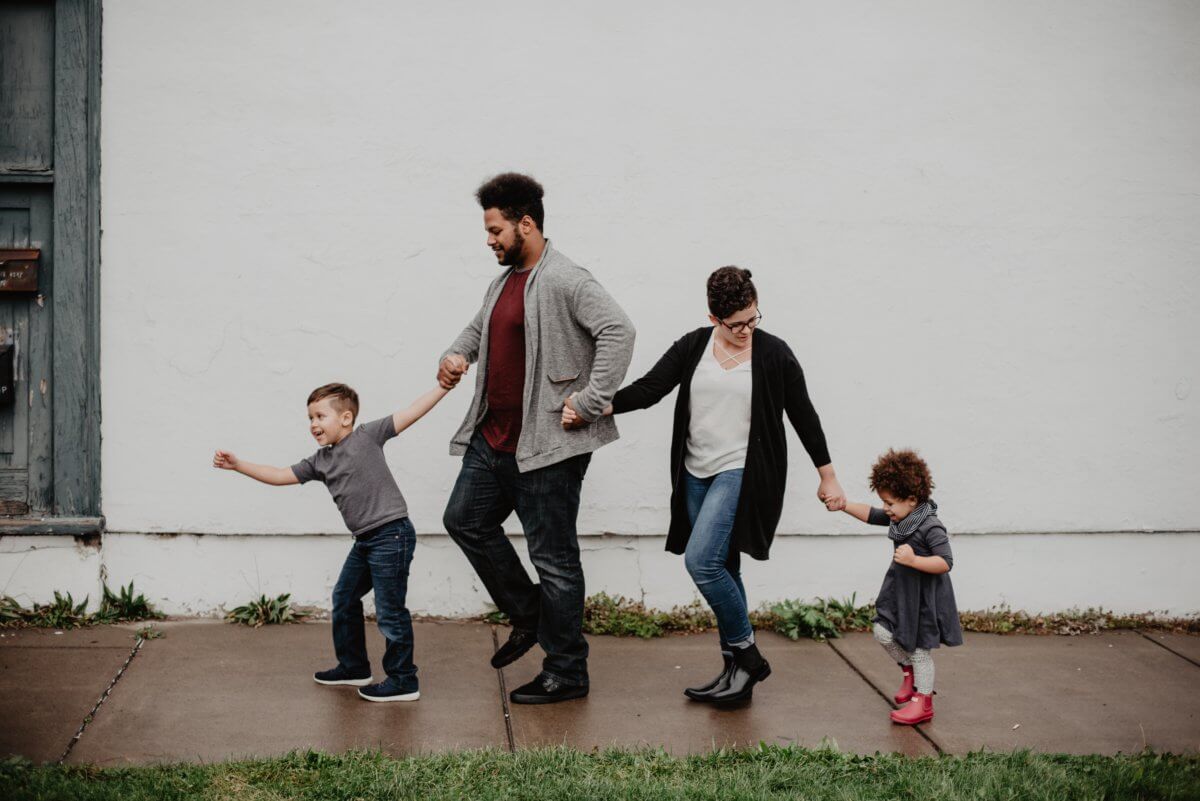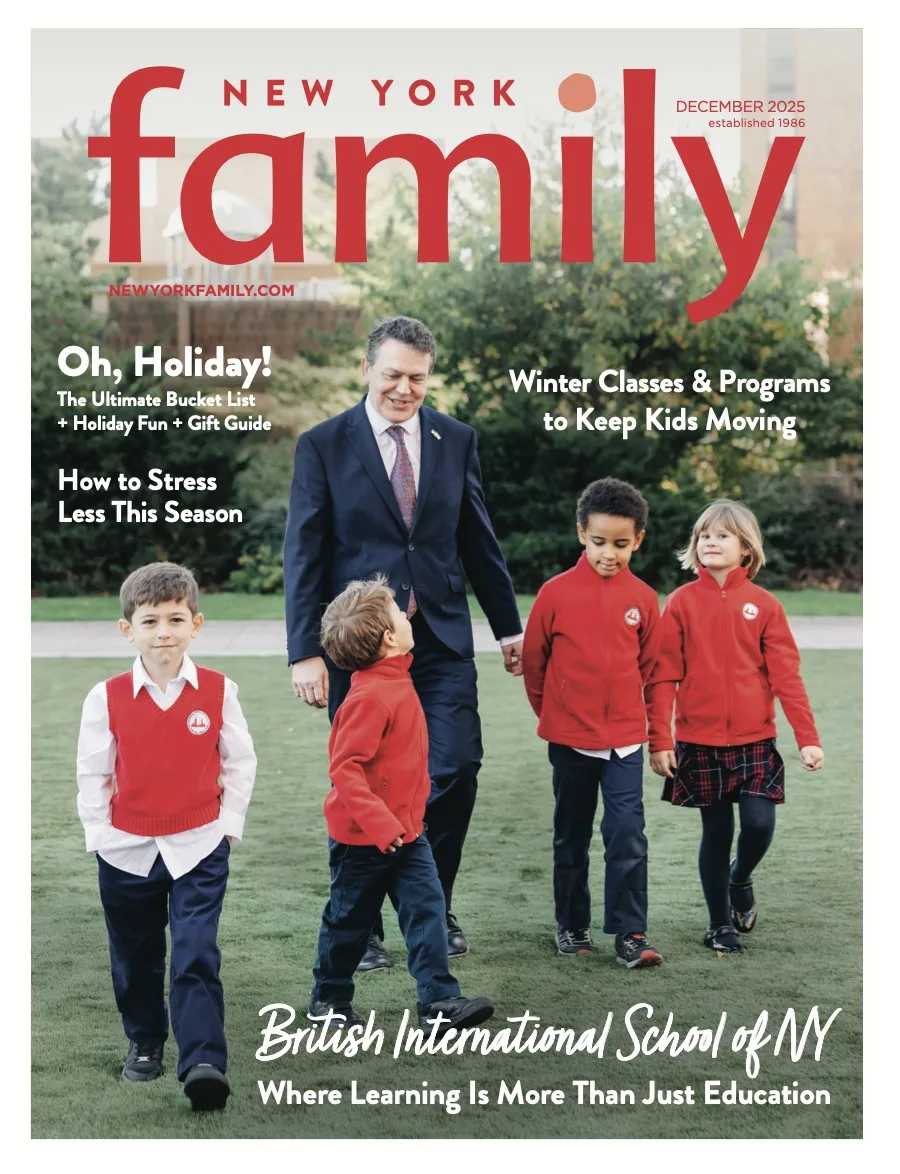
The Brady Bunch is the blended family turned spectacle. My blended family — my two stepsons, now 15 and 13, and two bio kids, now 4 and 1 — is like them only in that between the six of us, we have a lot of long, unruly hair — even the baby was born with a telltale mohawk. The Brady Bunch’s bathtub drain is never pictured on the show, nor which family member was responsible for cleaning it. That stuff gets edited out, because who would tune into what amounted to a hairball battle? (Also, sexism alert, it was likely the mom.) Unfortunately, that’s the stuff around which real-life drama and feelings mount, and it’s exactly the kind of “small thing, big deal” around which blended families must create their orbit and family culture.
Psst…Looking for more mom stories? Check out Being a New York Newbie
When my husband and two stepsons and I all moved into a fresh-start Brooklyn apartment together the year before our wedding, when the boys were 7 and 9, that was one of the first things I noticed: wow, there is a lot more hair around here! And each of us needed a different kind of hair tool: paddled brush, wide-tooth comb, bristle brush, none whatsoever. This was symbolic: we needed more room for everything too, including our feelings and tolerance for diversity of what works for you.
Perhaps the most important thing we are told to keep in mind to help children adjust to a blended family (especially when families with older siblings are merged) is: the children didn’t pick this. I was aware of that from the moment my husband first showed me their glowing faces on his iPhone.
That was forefront in my mind, a deep sensitivity to the changes that had taken place around them. It had happened gradually, but still: a new home is a new home, even if their room was bigger and better than at their dad’s former shoebox basement apartment, and the light beautiful. We called it “the castle” because of the turrets. The boys thought we lived in the suburbs, not a Brooklyn neighborhood that bordered on the park. They didn’t pick this. Give them room. No pressure to love the new set up. No suggestions that they must dislike it, either. Be a thermostat, gage their comfort zones.
But let’s be honest: children didn’t pick their biological parents, either. Nor did they pick to be born. We are always asking children to deal with what we’ve chosen for them. So blended families are simply that to the next level, plus the possibility that at some point in their past, more or less amicably, blended families include children whose lives were (radically) disrupted. Consciously or not, the fallout of that former partnership and disassembled household will be associated with the new family configuration.
So that was my job, which I had long practiced anyway, a kind of over-exposure to other people’s buried feelings. Be sensitive. I was lucky to build a friendship and rapport with my stepsons before they knew me as “Daddy’s girlfriend,” or “housemate” or “daddy’s fiancee” or “stepmom.” That didn’t make the change insignificant.
The very first thing I can tell you about blended families is: the adults need to do their homework, every day, and the messaging to the kids needs to match our behaviors, and we need to name hypocrisies and inconsistencies where they occur. Is it easy? Sometimes. Other times, it’s nebulous and complicated, and one of the things that makes life worth living.
Just like we need more space for everything we have when we combine two homes, two lives, or four or more lives, we need to practice loving bigger. It’s a bootcamp in redefining what loving people even means.
The adults need to sound a consistent note that love (or its less loaded forms: caring, affection) doesn’t mean picking between households, or parents from the old exploded or disassembled nuclear unit. It doesn’t come with a “more” or “less,” when we really look at its power. Love is love; and its allies in the blended family are patience and acceptance.
When we love each other or build relationships in blended families, we must give each other even more generous space for individual feelings, and show up consistently and steadily. That can definitely feel agonizing, at moments when the other person’s feelings are not what you would have designed.
Some of the following phrases have helped me to navigate sticky, unclear or complicated emotional terrain when I or my stepsons were in zones of discomfort — obvious or subtle. It’s pretty great how many situations these lines are applicable to:
“We know you didn’t choose it to be like this…thank you. Can we talk about…”
“We appreciate so much how you…”
“Maybe it’s annoying when I….I can understand…thank you for …..”
“I don’t know how it feels to be you, but when I think about what you’re dealing with I imagine it could feel…”
“I am not your biological parent, but many people have non-biological parents who love and care for them, and this is one way I love and care for you…”
“We see how awesomely you are teaching your little siblings…”
I do my inner homework, even when I don’t feel like it: What am I feeling? Why do I feel like this? What do I wish was happening right now? How can I show up authentically for all the kids, but not stuff down my feelings? To what degree is it appropriate to show or share my difficult feelings, when they arise — whether over the aforementioned bathtub drain or how much time their mom has spent on the phone with them while they are with us?
It’s too easy for a parent or the adult who is a bonus parent to convey (directly or indirectly) that it is the child’s job to tend to their feelings, or that the range of a child’s feelings in process are not welcome.
There are some other openers that build bridges across the blend, too — and, no surprise, these also can help in any family constellations:
“I bet you wish…”
“Should we make a list of ideas on how to handle XYZ?”
“Can we meet halfway? You are used to it/want it like this, I want it like this. Can we take turns getting out way? Can we pick a middle place we can agree on?”
I would never start any suggestion to another person about parenting, co-parenting, step-parenting or householding with “I promise this will work …” Being a person can be bewildering, and our needs differ. You might need space to work out feelings and thoughts, whereas I might need closeness to do so. But I don’t know anyone who doesn’t want to feel heard and validated, and like their inevitable slip-ups are human, and do-over’s possible.
Like any aspect of parenting, it’s essential to remember than nothing works every time, because our children, step-children and ourselves are changing day by day, sometimes hour by hour — and in particularly gusty moods, minute to minute. We don’t always know where our own feelings come from. Add to that forgotten gym shoes and overdue health care bills and misplaced hairbrushes and…sometimes we just need to sit down, drop everything and have our heads stroked. Yes, all that braided, bunchy, hair.













